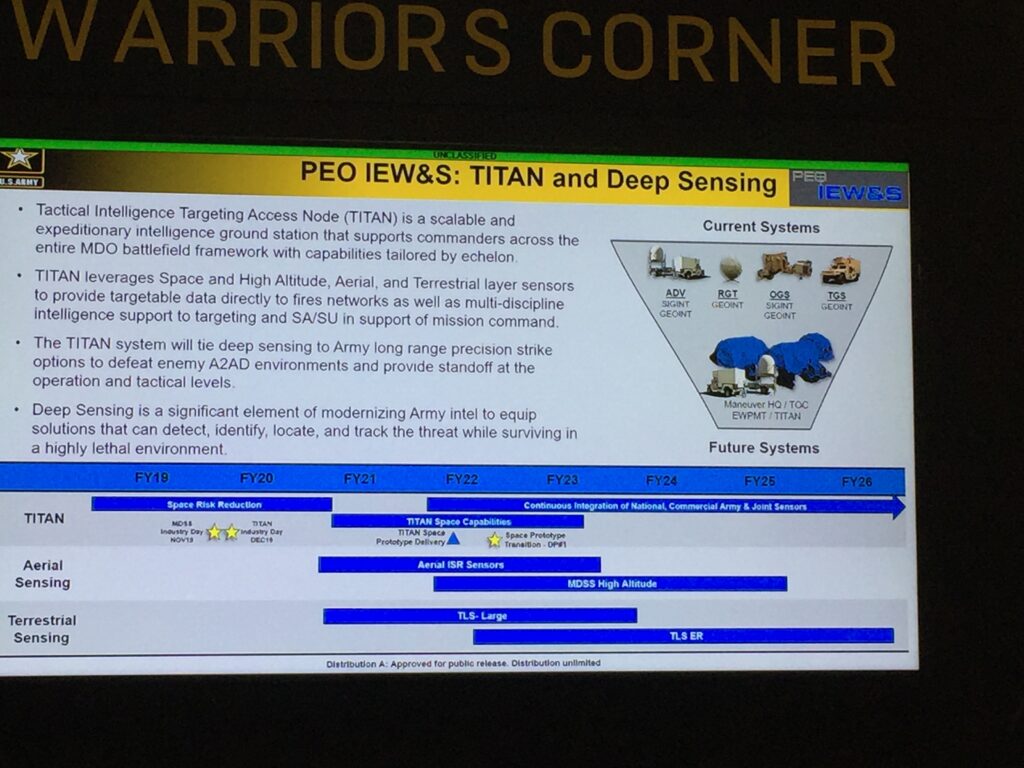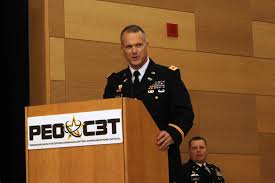 AUSA 2019: The Army its taking the next step in developing a key component of its multi-domain operations command and control as it fleshes out a blueprint for a ‘unified’ ground station to connect intelligence, surveillance and reconnaissance sensors from all domains. It will hold an industry day on Dec. 4 at Aberdeen Proving Ground in Maryland to discuss the Tactical Intelligence Targeting Access Node (TITAN).
AUSA 2019: The Army its taking the next step in developing a key component of its multi-domain operations command and control as it fleshes out a blueprint for a ‘unified’ ground station to connect intelligence, surveillance and reconnaissance sensors from all domains. It will hold an industry day on Dec. 4 at Aberdeen Proving Ground in Maryland to discuss the Tactical Intelligence Targeting Access Node (TITAN).
TITAN is envisioned as a “scalable and expeditionary intelligence ground station.” But it won’t just take data from satellites, as a traditional ground station. It will link with space, high altitude, aerial and terrestrial ISR sensors to provide targeting data directly to Army fires networks.
TITAN will be developed modularly, with the first prototype dedicated to the space component. TITAN Space — to link military, Intelligence Community and commercial satellites — is to debut by early fiscal 2022. Iterations to integrate aerial and high-altitude sensors will follow.
Brig. Gen. Rob Collins, program executive officer for intelligence, electronic warfare and sensors, explains that “in order to target deep, we have to be able to see deep.”
Speaking to the 2019 Association of the U.S. Army conference today, Collins stressed that they Army is not collecting ISR data purely “for the sake of collecting it,” rather “we collect it so we can distribute it to kinetic and non-kinetic weapon systems, and for commanders to be able to make decisions on the battlefield.”
Currently, he said, the Army has “about 101 tactical ground stations, about 13 operational ground stations” and a “smattering of other dissemination vehicles that do everything” from signals to geospatial intelligence. Not all of them can talk to each other, and not all of them are easily movable, he said.

Brig. Gen. Rob Collins
In particular, TITAN will “provide ‘deep sensing’ data to Army long range precision strike options to defeat enemy A2AD,” anti-access/aerial denial capabilities.
“We’re really looking at a LEGO type of approach,” Collins said, “a modular type of kit where I’ve kind of got a base infrastructure for my ground system, my TITAN system, that I can plug and play the extra kit based on the area of responsibility we’re able to go to, so I can tailor that by the particular mission.”
Key to this will be the use of open system architecture, and the integration of artificial intelligence and machine learning “to sift through this large amount of data so we can inform and improve the decision-making process, so that timing itself almost become a weapon.”
Finally, he said, one of the “game changers” for the multi-mode ground station will be a future capability not just “to receive the capabilities up in space, but the ability for the operational commander to be able task those assets, and orient them to areas they want to be able observe.”
The ability for tactical commanders to rapidly re-orient ISR satellites to hot spots has long been a bit of a holy grail for the Army, in part driving its interest in small satellites and even payloads hosted on commercial satellites. Traditional ISR satellites, owned and operated by the IC and the Air Force, are few and far between, and not directly in the Army’s command chain for tasking.
Providing sensor “task-ability” to mission commanders in the field, he said, is one of the most important future capabilities.
In a ‘world first,’ DARPA project demonstrates AI dogfighting in real jet
“The potential for machine learning in aviation, whether military or civil, is enormous,” said Air Force Col. James Valpiani. “And these fundamental questions of how do we do it, how do we do it safely, how do we train them, are the questions that we are trying to get after.”



























